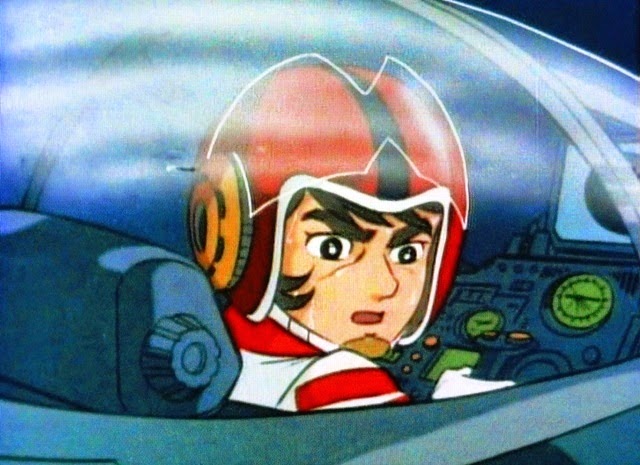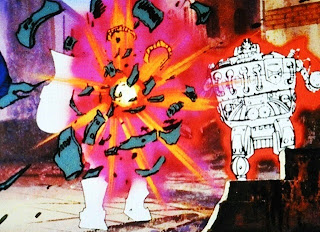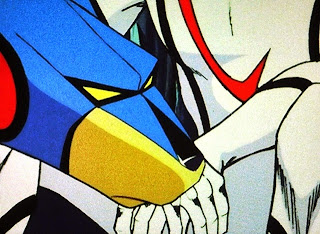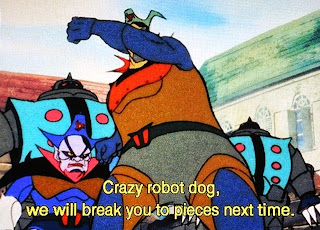"Now there are 364 days left..."
-Narrator-
It seems almost unconscionable that a space opera classic like Leiji Matsumoto's Space Battleship Yamato (1974-1975) translated and adapted for eyes on American shores as Star Blazers (1979), more specifically Star Blazers: The Quest For Iscandar, has yet to receive a proper remaster of its print and audio. Are you kidding me?! Damn licensors!


The American Star Blazers may not predate Star Wars (1977), but Space Battleship Yamato, on which Star Blazers is based, did so by three years. It is indeed a venerable classic in the world of science fiction as much as it was a landmark moment in anime. It's positively epic and it took mature risks, pushed boundaries and took paths many animated productions, particularly in the 1970s, simply feared to tread.
The series paid particularly close attention to its world building, its story, its characters and even propelled itself forward utilizing continuity and a complex serialized adventure.

Director Mamoru Oshii declared in a 2015 interview there are three crucial ingredients to a successful film: world-building, story and character (perhaps in that order). Well here, Star Blazers gets all of those elements right when so many series of the day looked to avoid the development or depth in their animated science fiction opting instead for neatly packaged stand alone tales that steered away real character development. The mythology building of Star Blazers made for must see television in the 1970s. Children celebrated the series every day after school. Repeats of the twenty-six episode epic were welcomed with bottles of Yoo Hoo and other assorted taste treats. This was matinee television at its finest.

Today, the best that can be offered to fans of the series is a sorry excuse of an old lackluster print by Voyager Entertainment. The legally available print option is filled with screen jiggle, dust and dirt particles, and loads of bleeding---the existing print is a mess! It's truly a shame that somebody, some company (Voyager Entertainment---you are at once thanked and cursed) hasn't been able to do something to repair this legitimate, unshakable classic. Honestly, the existing Voyager Entertainment DVD editions may be marginally better than what was available by boob tube in the 1970s. Musings Of A Sci-Fi Fanatic has done its best to clean up the images taken for the Star Blazers coverage. In fact, Voyager Entertainment is such a mess it began releasing the reimagined new Star Blazers 2199 (2013; Space Battleship Yamato 2199 by Yutaka Izubuchi) and ceased releasing the seven volume, 26 episode series with Volume 4. It just ended out of the blue with absolutely no word to fans on its future plans or if it would ever honor finishing the stateside release of the series. Incredible! To say Space Battleship Yamato as Star Blazers has gotten the short shrift here in the USA would be an understatement.

For Star Blazers the Yamato became the Argo, and complete with its powerful turrets and popular Wave Motion Gun would carry Earth's survivors and viewers on a massive, epic journey to Iscandar dubbed Star Blazers: The Quest For Iscandar. The title was intended to differentiate the original Star Blazers from its two sequels: Star Blazers: The Comet Empire (Series 2; originally release 1978) and Star Blazers: The Bolar Wars (Series 3; original release 1980).
The Quest For Iscandar centers around a crippled Earth destroyed by radioactive Gamilon planet bombs. The surface of the planet is now uninhabitable. Unfortunately, the poison radiation is seeping underground where mankind has fled. The remaining Earth Defense Force survivors have just one year to save Earth and one command ship, the Argo, to do it and complete the mission.


For all intents and purposes we begin our look back at this science fiction classic with Star Blazers: The Quest For Iscandar, Series 1, Part I (of six) which includes the first five episodes of the series.

White bearded, respected, revered even beloved Captain Avatar leads men and women against the forces of alien evil---the Gamilons. Hot shot Alex Wildstar is killed protecting Avatar and his crew. Young Derek Wildstar is devastated over his brother's death and to some degree holds Avatar directly accountable.

This introductory story thread of two brothers reminded me of a similar set up in Apollo and Zack within the original Battlestar Galactica (1978) Saga Of A Star World (here). Apollo's brother Zack is killed honorably in space combat fleeing the Cylon tyranny protecting the Galactica. These set-ups involving the death of a beloved brother pave the way to two space-faring classics in drawing us in to their stories of survival against a remorseless and relentless enemy. We are drawn into the characters, their sacrifice and ultimately the impact that loss has on family and loved ones within the crew. It's perhaps one of the most powerful human moments in Star Blazers' Episode 1, The Battle Of Pluto.

Derek Wildstar discovers the gorgeous, popping blond Astra, sister of Queen Starsha of Iscandar, on the surface of an Earth outpost who delivers plans to build a Wave Motion propulsion engine to take the Argo 148,000 light years to Iscandar to retrieve something called the Cosmo DNA which will save Earth. Wouldn't Starsha have saved a little time by scrapping the plans for the engine and simply delivering the Cosmo DNA? Mind you what would have become of the epic, storied journey of Star Blazers? What would have become of all the crew's trials and tribulations if that had happened? A classic anime simply would not have been birthed.

And thus a sunken World War II battleship, the Yamato turned Argo, is retro-fitted into a space vessel to carry these heroes across the universe. Despite the fact spaceship technology clearly existed it was an old World War II battleship that was ultimately necessary to be selected for the mission. It certainly makes for a visually impressive story. In fact, the Argo is quite simply one of the greatest spaceship ideas ever concocted in science fiction. It's also one of the absolute toy replica greats. Thank you!

On a cultural note, Brian Camp wrote in Anime Classics Zettai!: 100 Must-See Japanese Animation Masterpieces, "the notion of reviving and retooling a legendary Japanese battleship ... to save the world ... brought an unmistakable subtext of Japanese nationalism" (p.342). True. This is indeed one example of the intelligence woven into the fabric of the series.


Further speaking to the program's intelligence, one of the most affecting aspects of Star Blazers is how well it draws the viewer in sometimes by using nothing more than complete silence. The score will literally cease and the camera will zoom in or out on a moment and leave the silence to build emotion within the viewer. It's an impressive technique in anime particularly in the 1970s. When the score fills a moment it is never overbearing or obtrusive.
As a result of utilizing a sunken battleship, there is also a good deal more nautical imagery and verbiage utilized here, more so than Star Trek II: The Wrath of Khan (1982). Nautical terminology is indeed a facet in coloring the journey of Star Blazers.


Also notable is the bridge of the journeying Argo. There is great detail and affection paid to this immense bridge that could easily rest next to some of the iconic and glorious battle bridge greats of science fiction history like the one created for the original Battlestar Galactica.

A key theme of Star Blazers, in the face of complete and utter despair, was its mature, inspired and hopeful story---one that never loses sight of that hope. That is one of the most beautiful components of the classic series. The Argo itself is a symbol of that hope despite being a repurposed World War II battleship, ironically, initially a vessel of destruction. Now, the vessel, still a weapon, works to bring about peace and prosperity to the Earth. Our Star Blazers are heroic, noble or magnanimous of heart and spirit. It was a special time in the 1970s whereby heroes were decent, dignified and trusted on Battlestar Galactica, The Six Million Dollar Man (1973-1978), Battle Of The Planets (1978), Star Blazers and Star Wars (1977), to name just a few. There were indeed a great many genuine heroes---heroes without agendas or ulterior motives---for kids to emulate.

Author John Kenneth Muir of Reflections On Cult Movies And Classic TV adds, "I also appreciate the conceit at the crux of Star Blazers: that the secret of our future survival rests in our past. Yamato/Argo is just a 'pile of scrap metal' to some eyes, but the past can be re-purposed and made vital again if only we remember it, and learn its lessons. Thus I feel very strongly the Argo is a metaphor for how human beings face each day: experience and history are our guideposts, going forward. Star Blazers literalizes that notion with the Argo, a ship of war now transformed into a vehicle of hope." That is such an eloquent statement that speaks to the visual poetry of Star Blazers.

As Avatar proclaims in Star Blazers, "Now the ship has been brought back to life again not for the purpose of war although we'll no doubt see our share of battles, but to save Earth." Of course, what anime adventure would be a series without a few good battles?Fortunately, Avatar shares his message with the kids but promises them a good heap of action adventure to go along with their peace. Avatar understands that peace can only be achieved through a firm hand and the power required to protect one's self. How come so many others don't get that? Most want peace, but it comes at a price.


Also astounding, even as children we recognized the moral complexity and strength of narrative in this more mature or sophisticated series. They really weren't giving kids enough credit for a very long time, but clearly we were smarter than many recognized. Never did I walk away depressed after seeing an episode of Star Blazers, despite a tone that was clearly darker and more serious in nature. Instead I always felt invigorated by the show and infused with a sense of overarching justice and determination of spirit. It was a series with great, positive messaging that even a small boy could comprehend. But, even with kids as an expected audience, Star Blazers never condescended and generally never dumbed down its material in telling its faithful story. Finally, we were witnessing a shift of mindset. No longer were we being spoon fed stand alone tales of battle-heavy robot stories with no real connectivity. With Star Blazers we were weaving a story with each passing episode that required some reflection. With such great dramatic qualities and characters this was a true serialized space opera along the lines of the BBC's Doctor Who featuring Tom Baker (1974-1981). It was a magical period for kids.


Star Blazers' success with kids was the also the result of the creators' ability to populate a world with wonderfully real and colorful characters. The excellent English dub, too, was propelled dramatically by the late Gordon Ramsey (who voiced Captain Avatar) and Kenneth Meseroll (Derek Wildstar). Their voice work is worth mentioning as they had such a lasting dramatic effect and impact on my own memories of the show.
Key protagonist Derek Wildstar, his friend Mark Venture, beautiful nurse Nova, quirky Dr. Sane, chief engineer Orion, genius robot IQ-9 and many others were led by the warm, but hardened, Captain Avatar and guided to Iscandar by the stunning Queen Starsha. It was an unforgettable cast of characters.

The 1970s, too, was replete with wonderful older men who led the youngsters. Avatar was a perfect older lead in Star Blazers, a seemingly rare commodity in television, film and anime. Battle Of The Planets had its Chief Anderson. In Gaiking (1976-1977) men and women turned to Dr. Daimonji for sage advice. These series were always supported by strong leaders with wisdom and as kids we responded to that. In Japan there is or at least was a great respect for their elders and that translates well in these series. It seems to be that such wise assets or resources are undervalued today by comparison.

Dark, shadowy oversight groups with agendas (Ergo Proxy, Neon Genesis Evangelion) have become the standard rule of the day in some circles of anime.
Looking closer at Part I specifically, versus the series in general, many of the character introductions and story foundations are mapped out in Episode 1, The Battle Of Pluto and Episode 2, Carrier Attacks The Sleeping Yamato.

One historically noteworthy flashback scene featuring the Yamato in Space Battleship Yamato sees the ship actually battling on the sea against the United States during World War II. The sequence notes several pivotal moments of the ship prior to its sinking on April 7, 1945 in the Pacific during the Battle of Okinawa. The Japanese battleship Yamato was sent on a one-way mission to protect Okinawa intent on beaching itself and battling American forces to the very end. This sequence was edited out of the US release of Star Blazers.

The chief engineer Orion character has a beautiful monologue that speaks volumes about the beloved Captain Avatar in Episode 3, Ultra-Menace Missile. He explains to Wildstar, "You're not the only one to lose someone you care for. This is a cruel war. Many families are destroyed. Captain Avatar lost his only son in that same battle on Pluto. He's a fine leader. He knows what must be done. And even if he has to pay a price he does it and he doesn't blame others. He just goes on. Could you do the same?" Gosh, we could use some real leadership soon.

Also in Ultra-Menace Missile Avatar assembles a crew and speaks to the men and women who might accept the mission like both William Adamas spoke to their respective crews in both versions of Battlestar Galactica. We also learn more about the Wave Motion Gun and its use of tachyon particles. There's a holdeck and a replicator. More characters are introduced and we even discover Derek Wildstar isn't the only one who lost someone in war. Avatar, too, lost a son, but he's the kind of leader who doesn't talk of it. He carries it with him like a weight and makes efforts to move forward, despite the burden of suffering in silence, lift others up and win his war against Gamilon.

One of the highlights of Ultra-Menace Missile is Avatar leading the crew to prepare the launch of the Argo. The Wave Motion engine must build power. The creators deliver a real sense of urgency and don't rush the process lending credibility to the sheer power and weight and tension of the moment and in activating that engine. Clearly an engine of this magnitude would require time to build. There is a real sense of physics in play that makes the series more powerful and epic.



Those that inhabit the Argo and give her life are believable and emotionally resonate with viewers. The third episode keeps things interesting with regard to the relationship between Wildstar and Avatar. The elephant on the bridge is clearly the death of Wildstar's brother. Though Derek sees that his loss occurred on Avatar's watch there is still a begrudging and mutual respect bubbling under the surface for this young man. Even Wildstar senses something much more about Avatar in the early going. Connections are being made between these two strong-willed men.

Series 1, Part 1 continues with Episode 4, Test Warp To Mars. The pressures and realities of the mission of Star Force are beginning to rear their ugly heads as the crew prepares for a space warp. The warp must succeed or they'll end up in the fourth dimension of all places. Wildstar, Conroy and others head out in their Black Tiger fighter planes to hold off the Gamilons as the Argo powers up, locates the precise point of launch and prepares for warp. The episode becomes a real nail-biter particularly after Conroy is hit and makes every effort to get back to the Argo with only seconds to spare. It's an edge of your seat thrill ride. With characters living and dying Star Blazers makes it clear very early that characters are expendable. One wonders if Conroy will actually make it back alive. It's a well executed bit of drama.

And the Argo escapes an impending Gamilon Carrier that bears down upon them just moments before the space warp. The entire entry echoed an episode from the reimagined Battlestar Galactica by Ronald D. Moore. Test Warp To Mars had many of the hallmarks of the great hyper jump entry Battlestar Galactica, Season One, Episode 1, 33 (October 2004). Test Warp To Mars achieves much of what happens in that episode with old school hand drawn anime and did it in the original Space Battleship Yamato episode exactly thirty years ago to the month of the former's release. Though many, it stands to reason Star Blazers and Battlestar Galactica would share similarities given their epic, journey-based, linear narrative structures.

A minor gripe with the series logic is Mars. In the first two episodes Wildstar finds Astra on a Mars outpost and relays her urgent message for Earth home in a seeming hop, skip and a jump. By the time we reach Episode 4, the Argo needs to warp to get to Mars and it's a major event. Somehow the fact they make it to Mars doesn't seem to quite register with all that snow falling either. Shouldn't it be another planet? And then when they leave Mars for Jupiter (an even greater distance) they appear to be using normal propulsion systems. It's not perfect and it just wasn't adding up, but you let these things slide a bit.

Still, logic aside, the episode ends with a beautiful scene on Mars as snow falls upon the Argo and the crew take time to enjoy time outside of the ship. Families may have been destroyed by the Gamilons, but it's clear the members of Star Force are forging their own support system, their own makeshift family in their support of one another and their journey across the stars. And that's something to celebrate as they do together here. Once again young viewers sensed that camaraderie.

Series 1, Part 1, wraps up with Episode 5, Jupiter's Floating Continent. The episode is the first time we witness the awesome power (and associative whistling sound effect) of the Wave Motion Gun. We'll examine the Argo and the Wave Motion Gun more thoroughly in coverage for Star Blazers: The Quest For Iscandar, Series 1, Part II.

As the Argo is pulled into Jupiter's gravitational pull it lands on a methane-based floating, tropical-styled continent. The Gamilons have an outpost there. This refrain reminded me of the often unexpected Spectran outposts found in Battle Of The Planets. As the Argo prepares to break from the gravitational pull of the planet the Captain and crew implement the Wave Motion Gun and inadvertently destroy, not just the base, but the whole island continent underscoring the kind of weapon they have in their possession. They discover the awesome responsibility of their power provided by Queen Starsha of Iscandar. Once again, there is a splendid build up provided and given to the efforts of Star Force to use the Wave Motion Gun for the first time. They can't just pull the trigger and blow things up. Time is required and there are consequences that may and will result.

It's also fascinating just how much power lays in the hands of Avatar. Fortunately he is a responsible leader, but one imagine such power in the hands of the Gamilons. One equates it to the devastating Death Star controlled by the Empire in Star Wars that would post-date Space Battleship Yamato. Power on this scale in the wrong hands is unthinkable. A few countries come to mind.

At the end of each installment listeners would be informed that there were XXX many days remaining until the Earth dies giving this ongoing tale a sense of urgency. That was more than enough to keep the young, imaginative mind tuned in each week. This was an animated serialization like nothing kids had really ever experienced. But even as young people we responded to that idea and connected with it immediately long before such a concept was popularized on a regular, recurring basis (Lost, etc.) with so many other programs. Star Blazers was ahead of its time for anime and still remains a legitimate sci-fi classic.
The journey continues and now there are just 361 days left until the Earth is lost forever...









































